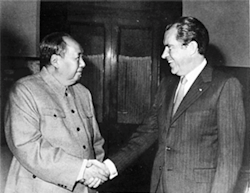In researching last month’s cover story on GSE history and this month’s China feature, we learned of an interesting story told by James Fallows in his 2012 book, “China Airborne.”
Fallows, a journalist and instrument-rated pilot, chronicles China’s soaring aviation ambitions in the book, and shares a story told to him by a man who served in the People’s Liberation Army Air Force before immigrating to the United States in the 1980s.
"Nixon goes to China" serves now as both a description of the actual trip President Richard Nixon made in 1972 and a useful methaphor for describing how only someone with an unassailable reputation like the hard-line anti-Communist Nixon could make peaceful overtures to such a traditional enemy like China was in those days.
Before Nixon's trip, however, Henry Kissinger made a secret trip to Beijing to thaw out the cold war relationship between the two countries. Kissinger, then Nixon’s national security advisor, would go undercover as just another passenger aboard a Boeing 707 operated by Pakistan International Airlines, which had operated scheduled service to China since the 1960s.
The 707, generally credited as ushering in the Jet Age, was one of the most recognizable planes at the time. In fact, Nixon’s Air Force One was none other than a 707.
But the Chinese authorities had one big problem. The 707 didn’t normally fly into the People's Republic of China. The country relied on its own commercial and military fleet that used mainly Soviet-model aircraft.
And the movable air stairs the Beijing authorities had on hand didn’t reach high enough.
“Would it have the right equipment to handle and service the plane?” Fallows writes. “At an even more basic and potentially embarrassing level, how was Kissinger supposed to get from the airplane onto the ground?”
Officially, the two countries couldn’t even talk to one another, but the Chinese certainly didn’t want Kissinger to jump off the 707. But neither could the authorities buy nor borrow air stairs from a Western supplier since this would reveal how out-of-date the country's airports were.
“Instead, they built their own in a rush,” Fallows concludes, “using pictures and published specs of the 707.”
When Kissinger’s plane arrived, the new air stairs were rolled out just like at any other international airport that was also ready to provide ground support for any type of aircraft.
So there you have it. One piece of GSE paves the way, ultimately, for the China we all know today.
Plus, it underscores many of the points raised by Francisco Chao in our feature on China’s aviation plans. The country may have built one air stair in a hurry four decades ago, but China needs outside vendors to ramp up its insatiatible pursuit of all things modern. But only up to a certain point. All along the country plans on being a builder serving the aviation market rather than just another consumer.
Plenty of international aviation companies are already teaching the Chinese to do what they do. Airbus, for example, set up its only plant outside Europe in Tianjin to assemble most of the planes China has agreed to buy. GE shares engine technology with a subsidiary of the Chinese Aircraft Corporation of China in order to supply engines to China’s own narrow-body jet. General aviation manufacturers have also set up production plants in China - and China made headlines in 2011 for buying Cirrus for $210 million.
Once that transfer of knowledge takes place, it’s may be like what Chao says. Whether you prefer to say ‘copy’ or ‘borrow,’ once the Chinese know how to do something, it’s thank you very much and we don’t need you any longer.
Nothing stands in the way of the fact that the Chinese can build more at lower cost (although not neccesarily better as Chao also points out) with a naturally bigger share sold to its own home market, which will be building three-quarters of the world's airports over the next 20 years. The scale of such a large domestic market can lead to exports around the world. And it's all China's gain.
All because of one custom-made air stair.

